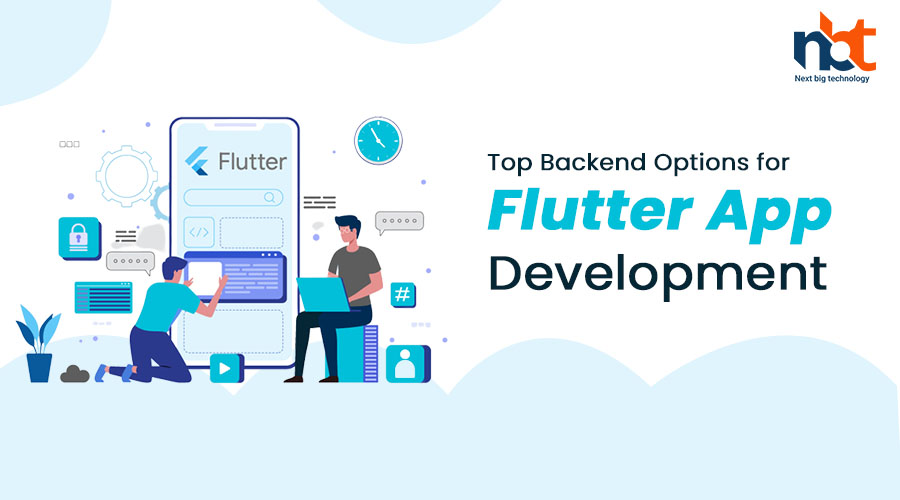Table of Contents
Introduction:
Flutter has gained immense popularity among developers as a cross-platform app development framework, allowing them to build beautiful and high-performance mobile apps. When it comes to developing Flutter apps, choosing the right backend solution is crucial for powering the app’s functionality, managing data, and enabling seamless communication with servers. In this blog, we will explore the top backend options for Flutter app development, including serverless solutions, traditional backend frameworks, and third-party services. Understanding these options will help developers make informed decisions when architecting the backend for their Flutter apps.
Best Backend Options for Flutter App Development
Firebase:
Firebase, a comprehensive platform by Google, offers a wide range of backend services suitable for Flutter app development. It provides features like real-time database, cloud storage, authentication, cloud functions, and hosting. Firebase’s real-time database, Firestore, allows developers to store and sync data in real-time, enabling seamless collaboration and offline capabilities. The authentication service simplifies user management and authentication workflows. Firebase also offers cloud functions for serverless backend logic and hosting for deploying Flutter apps with ease.
AWS Amplify:
AWS Amplify is a powerful backend development framework that integrates seamlessly with Flutter. It provides a suite of services, including authentication, storage, databases, and API development tools. With Amplify, developers can quickly set up scalable backends using AWS services like Amazon Cognito for user authentication, Amazon S3 for file storage, Amazon DynamoDB for NoSQL database storage, and AWS AppSync for building real-time GraphQL APIs. Amplify also offers an intuitive CLI (Command Line Interface) for easy project setup and deployment.
Node.js with Express.js:
Node.js, a JavaScript runtime, along with the Express.js framework, is a popular choice for building scalable and efficient backends for Flutter apps. Node.js allows developers to write server-side code using JavaScript, enabling seamless communication between the client-side Flutter app and the backend. Express.js, a minimalist web framework for Node.js, simplifies route handling, middleware implementation, and API development. With a vast ecosystem of libraries and modules, Node.js provides flexibility and speed for building robust backend services.
Django:
Django, a high-level Python web framework, offers a solid backend solution for Flutter app development. With Django, developers can build scalable and secure web APIs quickly. Django provides a robust ORM (Object-Relational Mapping) for database management, authentication, caching, and URL routing. Its batteries-included approach, coupled with a vast ecosystem of libraries, simplifies backend development tasks and speeds up the overall development process.
Ruby on Rails:
Ruby on Rails, also known as Rails, is a popular backend framework that follows the MVC (Model-View-Controller) architectural pattern. It provides a convention-over-configuration approach, making it easy for developers to build powerful APIs for Flutter apps. Rails offers features like ORM, routing, session management, and authentication out of the box, reducing the time spent on repetitive tasks. Its clean syntax and emphasis on developer productivity make Ruby on Rails a solid choice for backend development.
Laravel:
Laravel, a PHP-based backend framework, offers a modern and elegant solution for Flutter app development. It provides a clean and expressive syntax, along with a comprehensive set of features for building scalable and secure APIs. Laravel includes features like routing, ORM (Eloquent), authentication, caching, and task scheduling. With Laravel, developers can leverage the power of PHP to create robust and performant backend services.
GraphQL:
GraphQL, although not a traditional backend framework, is a query language and runtime that provides a flexible and efficient way to define and consume APIs. It allows developers to define the shape of the data they need, reducing over-fetching and under-fetching of data. GraphQL enables clients, including Flutter apps, to request multiple resources in a single query, improving performance and reducing network overhead. Implementing GraphQL on the server-side can be done using frameworks like Apollo Server, GraphQL Yoga, or Express.js with the GraphQL middleware.
Custom Backend with RESTful APIs:
For developers who prefer more control and flexibility, building a custom backend with RESTful APIs is a viable option. This approach involves creating a backend server using a programming language or framework of choice, such as Java with Spring Boot, .NET with ASP.NET Core, or PHP with Slim Framework. With RESTful APIs, developers can define endpoints and data models, enabling communication between the Flutter app and the backend server using HTTP requests and responses.
Third-Party Backend-as-a-Service (BaaS) Providers:
Several third-party services offer Backend-as-a-Service (BaaS) solutions, providing ready-to-use backend functionality for Flutter apps. These services handle server infrastructure, database management, user authentication, push notifications, and other common backend tasks. Examples of BaaS providers include Parse, Backendless, and Kinvey. These platforms abstract away the complexity of backend development, allowing developers to focus on building the frontend of their Flutter apps.
Serverless Architectures:
Serverless architectures, such as AWS Lambda or Google Cloud Functions, provide a cost-effective and scalable backend solution for Flutter apps. With serverless, developers can write and deploy functions or microservices that run in the cloud, triggered by events or API calls. Serverless architectures offer auto-scaling, pay-per-use pricing, and easy integration with other cloud services. By adopting serverless, developers can focus on writing application logic rather than managing server infrastructure.
Conclusion:
Choosing the right backend solution is crucial for successful Flutter app development. Firebase, AWS Amplify, Node.js with Express.js, Django, Ruby on Rails, Laravel, GraphQL, custom RESTful APIs, BaaS providers, and serverless architectures provide a wide range of options to suit different requirements and development preferences. Evaluating the specific needs of your Flutter app, such as scalability, real-time capabilities, authentication, and data management, will help guide your decision in selecting the most suitable backend option. By leveraging these top backend options, Flutter developers can build robust, scalable, and feature-rich mobile apps that deliver exceptional user experiences.
Thanks for reading our post “Top Backend Options for Flutter App Development”. Please connect with us to know more about Flutter App Development.

















